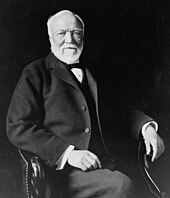Carnegie Mellon University (Carnegie Mellon or CMU is a private research university inPittsburgh, Pennsylvania.
Founded in 1900 by Andrew Carnegie as the Carnegie Technical Schools, the university became the Carnegie Institute of Technology in 1912 and began granting four-year degrees. In 1967, the Carnegie Institute of Technology merged with the Mellon Institute of Industrial Research to form Carnegie Mellon University.
The university's 143-acre (58 ha) main campus is 3 miles (4.8 km) from Downtown Pittsburgh. Carnegie Mellon has seven colleges and independent schools: the College of Engineering, College of Fine Arts, Dietrich College of Humanities and Social Sciences,Mellon College of Science, Tepper School of Business, H. John Heinz III College and the School of Computer Science. The university also has campuses in Qatar and Silicon Valley, with degree-granting programs in six continents.
Carnegie Mellon consistently ranks in the top 25 in the national U.S. News & World Report rankings. It is home to the world’s first degree-granting Robotics and Drama programs, as well as one of the first Computer Science departments. The university conducted over $703 million in research in 2015.
Carnegie Mellon counts 13,650 students from 114 countries, over 100,000 living alumni and over 5,000 faculty and staff. Past and present faculty and alumni include 19 Nobel Prize Laureates, 19 Members of the American Academy of Arts & Sciences, 72 Members of the National Academies, 114 Emmy Award Winners, 41 Tony Award laureates, 7 Academy Award Winners, and 12Turing Award winners
History
Post-Civil War industrialists accumulated unprecedented wealth and some were eager to found institutions in their names as part of philanthropy campaigns using portions of their vast wealth. Washington Duke at Duke University, Ezra Cornell at Cornell University, Johns Hopkins at Johns Hopkins University, Leland Stanford at Stanford University, John D. Rockefeller at the University of Chicago, and Cornelius Vanderbilt at Vanderbilt University are several notable examples of Andrew Carnegie's gospel of wealth mentality and Carnegie Mellon University is one such result.
Institutional formation
The Carnegie Technical Schools were founded in 1900 in Pittsburgh by the Scottish American industrialist and philanthropist Andrew Carnegie, who wrote the time-honored words "My heart is in the work", when he donated the funds to create the institution. Carnegie's vision was to open a vocational training school for the sons and daughters of working-class Pittsburghers (many of whom worked in his mills). Carnegie was inspired by the Pratt Institute in Brooklyn, New York founded by industrialist Charles Pratt in 1887, modeling many aspects for his own school from Pratt. Three consultants were retained to direct the design of the curriculum and campus; among them was Clifford B. Connelley, a pioneer of vocational education and future Pennsylvania Commissioner of Labor and Industry. In 1912 the institution changed its name to Carnegie Institute of Technology (CIT) and began offering four-year degrees. During this time, CIT consisted of four constituent schools: the School of Fine and Applied Arts, the School of Apprentices and Journeymen, the School of Science and Technology, and the Margaret Morrison Carnegie School for Women.
The Mellon Institute of Industrial Research was founded in 1913 by brothers Andrew Mellon and Richard B. Mellon in honor of their father, Thomas Mellon, the patriarch of theMellon family. The Institute began as a research organization which performed work for government and industry on contract and was initially established as a department within the University of Pittsburgh. In 1927, the Mellon Institute incorporated as an independent nonprofit. In 1938, the Mellon Institute's iconic building was completed and it moved to the new location.
In 1967, with support from Paul Mellon, Carnegie Tech merged with the Mellon Institute of Industrial Research to become Carnegie Mellon University. Carnegie Mellon's coordinatewomen's college, the Margaret Morrison Carnegie College closed in 1973 and merged its academic programs with the rest of the university.
The industrial research mission of the Mellon Institute survived the merger as the Carnegie Mellon Research Institute (CMRI) and continued doing work on contract to industry and government. CMRI closed in 2001 and its programs were subsumed by other parts of the university or spun off into independent entities.

